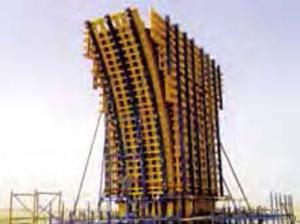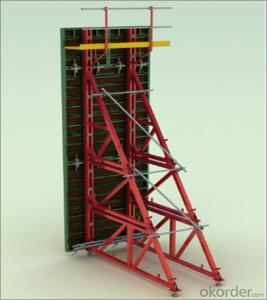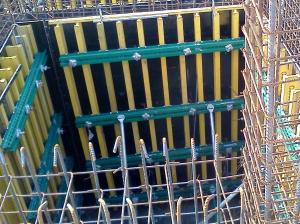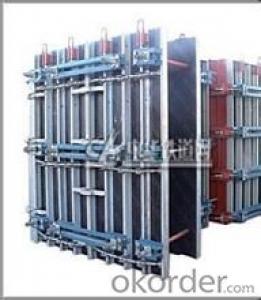Circular Column Formwork Outrigger for Scaffolding
- Loading Port:
- Tianjin
- Payment Terms:
- TT OR LC
- Min Order Qty:
- 5000 set
- Supply Capability:
- 50000 set/month
OKorder Service Pledge
OKorder Financial Service
You Might Also Like
Circular Column Formwork Outrigger For Scaffolding
Developing with new technology materials, steel formworks is no longer a must in construction concrete process. More and more buildings are established with plastic formworks. And workers love this new formworks much more.
The advantages of plastic formworks:
1.First of all--light
Yes it is the first advantage of plastic formwork. It wins the great praise of both contractors and workers.
The biggest panel is 120×1500px,weights 10.5kg only. It can be lift and set up by one person easily, which means there is no need for cranes on site.Saves a lot of cost and time.
2.Easy set up
Different size of panels can firmly locked by simply turn the special handles to 90 degree. The Panels has rib on the back, which makes the system need not traditional wood blocks and nails. The panels have holes to fit tie rod, guarantee the strength of the whole system.
4.Strength
The handles are made by high strength Nilon, each panel locked by at least 4 handles, which makes the whole system strong enough to pour 1000px walls.
5.Environment friendly
The system needs no cut and nail due to the variety size. Also it needs nearly no wood. The material can be recycled after broken, so it will not pollute the environment.
6.Consequent
Concrete does not stick to plastic formwork, thus the panels need no oil before using, and can be cleaned simply by water. The surface of the wall which build by modular formwork is smooth and without rework.
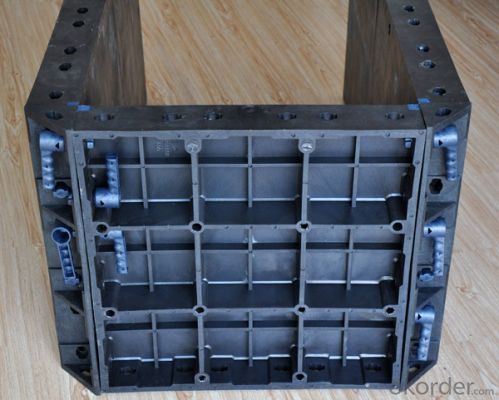
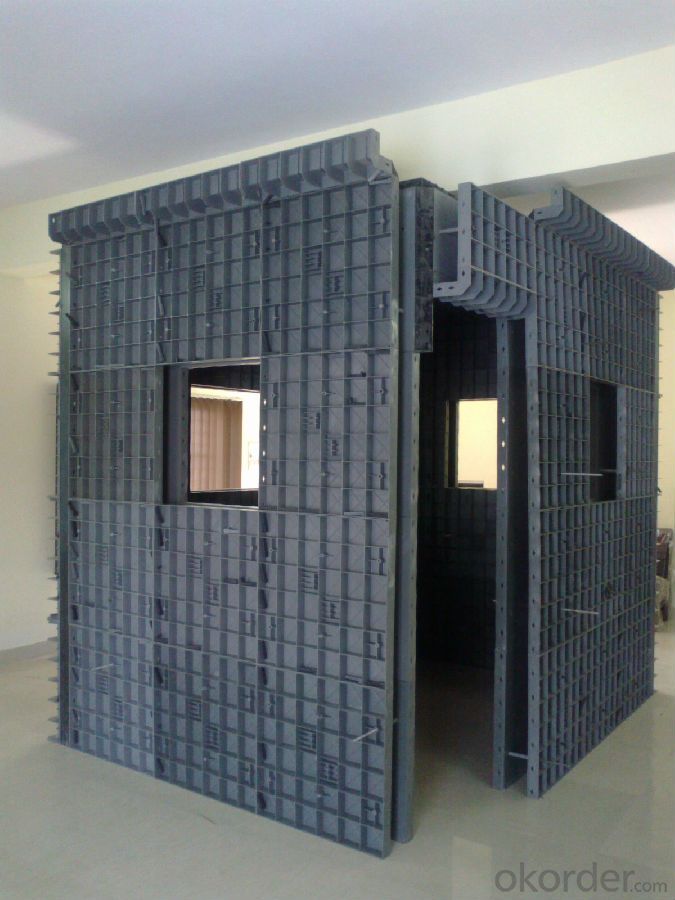
Advantage
* Good loading capacity
* Easy to assemble and dismantle
* Stable and durable thanks to its structual design & automatic welding quality
* Customized solution helps you work safe, save cost and convenient
* Excellent quality for formwork & scaffolding
Packing
in bulk or in bundle, or as requested
Shipping
15-20 Days.
Normally small orders, it needs just 15-20 business days to the port.
Other scaffolding & formwork products:
(1) Scaffolding System:
Including Ringlock Scaffolding System and accessories; Cuplock Scaffolding System and accessories; Kwikstage Scaffolding System and accessories; Haki Scaffolding System and accessories;
(2) Scaffolding Frame & Accessories:
Including Walk Through Frame Scaffolding; Ladder Frame Scaffolding; Accessories; we also can make scaffolding according to your samples or drawings.
(3) Scaffolding Couplers/Clamps:
We can produce all kinds of forged and pressed couplers, including British type couplers, American type couplers, German type couplers, Italian type couplers ,fence couplers, BRC coplers and so on. We also can produce according to your drawings or samples.
(4) Formwork System Scaffolding & Accessories:
Light Duty Shoring prop and Heavy Duty Shoring Prop; Wing nuts and Tie rods; RASTO clamp and so on.
FAQ
Why Us?
We are one of the Top 500 in the world, largest construction materials supplier in China. Also we are a state-owned company and respond to every customer with large and also small orders.
We own professional manufacturers with powerful producing capacity.
Extensive and comprehensive quality control system
Full energy with affluent experience team.
- Q:What are the common quality control measures for steel frame formwork systems?
- Quality control measures for steel frame formwork systems in the construction industry are implemented to guarantee the formwork system's integrity, strength, and safety during the concrete pouring process. Key quality control measures include: 1. Material Inspection: Thoroughly inspecting the materials used in the steel frame formwork system is the first step in the quality control process. This involves assessing the steel's quality, specifications, welding quality, surface finish, and overall structural strength. 2. Dimensional Accuracy: Ensuring precise dimensions and tolerances during the manufacturing of the steel frame formwork system is crucial. This requires verifying the accuracy of measurements, angles, and alignments of the formwork system components to avoid misalignment and compromised structural integrity. 3. Load Testing: Evaluating the load-bearing capacity and overall stability of the steel frame formwork system through load testing is essential. Simulated loads are applied to the system to assess its ability to withstand expected construction loads without failure or deformation. 4. Safety Inspections: Regular inspections are conducted to ensure the proper installation and functioning of safety features such as handrails, guardrails, and access points. Compliance with industry safety standards and regulations is also verified. 5. Documentation and Record Keeping: Proper documentation and record keeping play a vital role in quality control for steel frame formwork systems. This includes maintaining records of material certifications, inspection reports, load testing results, and safety compliance documents to ensure traceability and accountability. 6. Inspection of Formwork Joints: The joints between different formwork components are inspected to ensure proper alignment and integrity. Gaps, misalignments, or loose connections that could compromise the stability and strength of the formwork system are checked. By implementing these quality control measures, construction companies can ensure that steel frame formwork systems are manufactured and installed to the highest standards. This minimizes the risk of structural failures, enhances worker safety, and ensures successful completion of construction projects.
- Q:Can steel frame formwork be used for sports and recreational facilities construction?
- Yes, steel frame formwork can be used for sports and recreational facilities construction. Steel frame formwork is a versatile construction system that provides a strong and durable framework for concrete structures. It is widely used in various construction projects, including sports and recreational facilities. The strength and rigidity of steel make it an ideal choice for constructing large and complex structures, such as stadiums, indoor arenas, swimming pools, and gymnasiums. Steel frame formwork can easily support the weight of the concrete and withstand the forces exerted by the structure. This ensures the stability and integrity of the facility, providing a safe and functional space for sports and recreational activities. Additionally, steel frame formwork offers flexibility in design and allows for customization according to the specific requirements of the facility. It can be easily adjusted and modified to accommodate different architectural features, such as curved walls, grandstands, and unique shapes. This allows architects and designers to create aesthetically appealing and innovative sports and recreational facilities. Moreover, steel frame formwork is known for its durability and longevity. It can withstand harsh weather conditions, heavy loads, and regular wear and tear, making it suitable for long-term use in sports and recreational facilities. The use of steel also contributes to the sustainability of the construction, as it is a recyclable material and can be reused or repurposed in the future. In conclusion, steel frame formwork is a suitable choice for the construction of sports and recreational facilities. Its strength, flexibility, and durability make it an ideal construction system to support the design and functionality of such structures.
- Q:How does steel frame formwork handle concrete curing in hot conditions?
- Steel frame formwork handles concrete curing in hot conditions by providing a stable and strong structure that can withstand the high temperatures. The steel frames are designed to hold the weight of the concrete and provide support during the curing process. In hot conditions, the steel frame formwork helps to regulate the temperature of the concrete by providing insulation. This prevents the concrete from drying out too quickly and ensures a more controlled curing process. The steel frames also help to reduce the risk of cracking or shrinkage due to the heat. Additionally, steel frame formwork allows for proper ventilation and air circulation around the concrete, which helps to dissipate excess heat and prevent the concrete from becoming too hot. This is important as excessive heat can cause thermal cracking and weaken the structure. Furthermore, steel frame formwork is highly durable and can withstand the expansion and contraction that occurs during the curing process in hot conditions. This ensures that the structure remains stable and secure. Overall, steel frame formwork is a reliable and effective solution for handling concrete curing in hot conditions. It provides the necessary support, insulation, and ventilation to ensure a successful and durable curing process.
- Q:Can steel frame formwork be used for both wall and column construction?
- Steel frame formwork is applicable for both wall and column construction. It is a versatile and long-lasting solution that can be effortlessly assembled and disassembled, rendering it well-suited for various construction undertakings. This formwork type delivers exceptional support and stability throughout the pouring and curing phases, guaranteeing precise and accurate outcomes. Whether it involves wall or column construction, steel frame formwork caters to the distinctive needs of each project by offering the necessary strength and flexibility. It is widely employed in commercial, industrial, and residential construction, serving as a dependable and effective method for crafting robust and resilient structures.
- Q:Are there any limitations to the shape or design of structures that can be constructed using steel frame formwork?
- Steel frame formwork does have limitations in terms of shape and design of structures that can be built. It is a widely used and versatile construction technique, but certain considerations must be made during the design phase. One limitation is the difficulty in constructing curved or irregular shapes. Steel frame formwork works best for structures with straight lines and right angles. Building complex curved or irregular shapes can be challenging and may require customization and additional fabrication. Another limitation is the size and weight of the structure. Steel frame formwork can handle large and tall structures, but there are practical limits to the achievable size and weight. The weight of the formwork and the concrete being poured can strain the steel frames and supports, necessitating careful engineering to maintain structural integrity. Additionally, the height and depth of the structure can be limiting factors. Steel frame formwork systems are typically modular and adjustable, but there are practical limits to the attainable height and depth. Beyond a certain point, additional support systems may be necessary for stability and safety. Lastly, the aesthetic design of the structure may be constrained by the use of steel frame formwork. While finishes and cladding materials can be applied to the formwork, the exposed areas will still have a distinct steel frame appearance. This may not be suitable for certain architectural designs that require a different aesthetic. In conclusion, steel frame formwork is a versatile construction technique, but it does have limitations in terms of shape, size and weight, height and depth, and aesthetic design. These limitations should be carefully considered during the design phase to ensure the practicality and feasibility of using steel frame formwork for a specific structure.
- Q:How long does it take to install steel frame formwork?
- The time it takes to install steel frame formwork can vary depending on several factors. These factors include the size and complexity of the project, the experience and skill level of the workers, and the availability of equipment and resources. In general, installing steel frame formwork can be a relatively time-consuming process. It typically involves several steps, such as setting up the support system, assembling the steel frames, and securing them in place. The process may also include additional steps like installing reinforcing bars and pouring concrete. For smaller and simpler projects, the installation of steel frame formwork can take anywhere from a few hours to a couple of days. However, for larger and more complex projects, the installation process can take several days or even weeks. It is important to note that the time required for installation can also be influenced by external factors, such as weather conditions and site accessibility. Adverse weather conditions or difficult site conditions can significantly impact the installation timeline. To get a more accurate estimate of the installation time for a specific project, it is best to consult with experienced professionals or contractors who specialize in steel frame formwork installations. They will be able to assess the project requirements and provide a more precise timeline based on their expertise and experience.
- Q:What types of concrete structures can be built using steel frame formwork?
- Steel frame formwork is versatile and can be used to build a wide range of concrete structures. Some examples include high-rise buildings, bridges, tunnels, dams, and even complex architectural designs. The steel frame provides the necessary support and stability during the pouring and curing process, enabling the construction of durable and robust concrete structures.
- Q:What are the quality control measures for steel frame formwork reassembly?
- Quality control measures for steel frame formwork reassembly involve various steps to ensure the accuracy and reliability of the process. These measures typically include thorough inspection of the formwork components for any damages or defects, proper cleaning and preparation of the components before reassembly, ensuring correct alignment and positioning of the steel frames, verifying the stability and strength of the connections, and conducting quality checks at each stage of the reassembly process. Additionally, regular monitoring and supervision by qualified personnel, adherence to relevant industry standards and guidelines, and documentation of the entire reassembly process are essential quality control measures to ensure the successful and safe use of steel frame formwork.
- Q:Can steel frame formwork be used for underwater concrete placement?
- Yes, steel frame formwork can be used for underwater concrete placement. Steel formwork systems are durable, strong, and resistant to water, making them suitable for such applications. They can withstand the pressure exerted by water and provide the necessary support and shape to the underwater concrete during the placement process.
- Q:Can steel frame formwork be used for high-strength concrete?
- High-strength concrete can indeed be accommodated by steel frame formwork. Renowned for its durability and strength, steel frame formwork proves to be an apt choice for handling high-strength concrete. The rigid structure of the steel frame imparts stability and support, enabling the formwork to withstand the immense pressure exerted by the high-strength concrete. Moreover, the employment of steel frame formwork guarantees precise and accurate placement of the concrete, resulting in the fulfillment of the desired strength requirements. Nevertheless, it is imperative to carefully assess the design and specifications of the steel frame formwork to ascertain its compatibility with the specific needs of high-strength concrete. Adequate reinforcement and bracing might be essential to ensure that the formwork is capable of enduring the augmented loads associated with high-strength concrete.
1. Manufacturer Overview |
|
|---|---|
| Location | |
| Year Established | |
| Annual Output Value | |
| Main Markets | |
| Company Certifications | |
2. Manufacturer Certificates |
|
|---|---|
| a) Certification Name | |
| Range | |
| Reference | |
| Validity Period | |
3. Manufacturer Capability |
|
|---|---|
| a)Trade Capacity | |
| Nearest Port | |
| Export Percentage | |
| No.of Employees in Trade Department | |
| Language Spoken: | |
| b)Factory Information | |
| Factory Size: | |
| No. of Production Lines | |
| Contract Manufacturing | |
| Product Price Range | |
Send your message to us
Circular Column Formwork Outrigger for Scaffolding
- Loading Port:
- Tianjin
- Payment Terms:
- TT OR LC
- Min Order Qty:
- 5000 set
- Supply Capability:
- 50000 set/month
OKorder Service Pledge
OKorder Financial Service
Similar products
New products
Hot products
Related keywords

